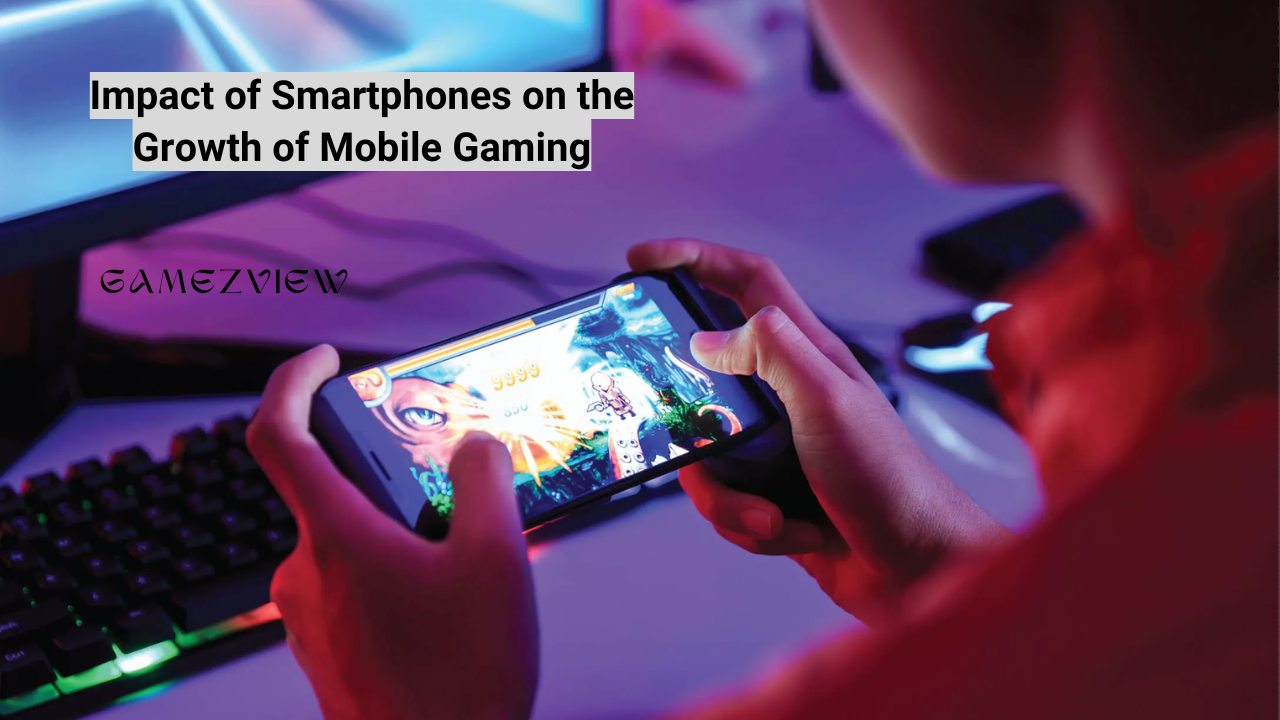The evolution of mobile gaming has been nothing short of revolutionary, largely due to the widespread adoption and continuous advancement of smartphones. Over the past decade, smartphones have not only transformed how we communicate and access information but have also redefined entertainment, particularly in the realm of gaming. The symbiotic relationship between smartphones and mobile gaming has created a massive industry that rivals traditional gaming platforms in both revenue and user engagement. This article delves into the impact of smartphones on the growth of mobile gaming, exploring how technological advancements, accessibility, and changing user behaviour have contributed to the phenomenon.
The Rise of Smartphones: A Game-Changer for Mobile Gaming
Early Days of Mobile Gaming
Mobile gaming dates back to the era of basic mobile phones, with the introduction of simple games like “Snake” on Nokia devices in the late 1990s. These games, while popular, were limited by the technology of the time—low-resolution screens, minimal processing power, and rudimentary controls. The potential for mobile gaming was evident, but the industry required more sophisticated hardware and software to truly take off.
The Advent of Smartphones
The launch of the first iPhone in 2007 marked a turning point in the mobile gaming industry. The iPhone’s touch screen, combined with its accelerometer and advanced graphics capabilities, opened up new possibilities for game developers. The introduction of the App Store in 2008 further revolutionized the market by providing a platform where developers could distribute their games directly to users. This democratization of game distribution, combined with the rapidly growing user base of smartphones, set the stage for exponential growth in mobile gaming.

Technological Advancements Driving Mobile Gaming Growth
Processing Power and Graphics
One of the most significant factors in the growth of mobile gaming is the continuous improvement in smartphone processing power. Modern smartphones are equipped with powerful processors, capable of handling complex calculations and high-quality graphics that were once the domain of dedicated gaming consoles. These advancements have enabled the development of visually stunning and performance-intensive games, such as “PUBG Mobile” and “Call of Duty Mobile,” which deliver console-like gaming experiences on handheld devices.
High-Resolution Displays and Touchscreen Interfaces
The evolution of smartphone displays has also played a crucial role in the rise of mobile gaming. High-resolution screens with vibrant colours and fast refresh rates enhance the visual experience, making games more immersive. Touchscreen interfaces, coupled with features like haptic feedback, have transformed how users interact with games, allowing for intuitive controls that are well-suited to a wide variety of game genres.
Connectivity and Online Multiplayer Gaming
Smartphones have also capitalized on advancements in connectivity, particularly with the widespread adoption of 4G and now 5G networks. These high-speed internet connections enable seamless online multiplayer gaming experiences, allowing users to compete and collaborate with players around the world in real time. Games like “Fortnite” and “Clash Royale” have leveraged this capability, creating large, engaged communities of players who participate in online battles, tournaments, and events.
Differences Between Mobile Gaming and Traditional Gaming: A Comprehensive Analysis
Accessibility and the Democratization of Gaming
The App Store and Google Play: Global Distribution Channels
The availability of mobile games through digital distribution platforms like the App Store and Google Play has made gaming more accessible than ever before. These platforms offer a vast library of games, ranging from casual puzzle games to complex strategy titles, all available at the tap of a finger. This ease of access has attracted a diverse audience, including demographics that might not have traditionally engaged with gaming, such as older adults and women.
Freemium Model: Lowering Barriers to Entry
The freemium business model, where games are free to download but offer in-app purchases for additional content or features, has further fueled the growth of mobile gaming. This model lowers the barrier to entry for users, allowing them to try games without any upfront cost. Developers, in turn, benefit from a larger player base and the potential for significant revenue through microtransactions. Games like “Candy Crush Saga” and “Pokémon GO” have successfully employed this model, generating billions in revenue while maintaining large, active user bases.
Accessibility Across Devices and Platforms
Another critical aspect of smartphones’ impact on mobile gaming is the cross-platform accessibility they provide. Unlike traditional gaming consoles or PCs, which require specific hardware, smartphones offer a more inclusive approach. A single game can be played across various devices, from smartphones to tablets, and in some cases, even across different operating systems. This cross-platform playability has broadened the reach of mobile games, making them accessible to a more extensive and varied audience.

Changing User Behavior and Gaming Culture
The Casual Gaming Phenomenon
Smartphones have popularized casual gaming, a genre characterized by simple gameplay mechanics, short session lengths, and broad appeal. Casual games like “Angry Birds,” “Fruit Ninja,” and “Temple Run” have become household names, attracting millions of players who might not consider themselves traditional gamers. The convenience of playing games on the go, during commutes, or in short breaks, has made casual gaming a pervasive part of daily life.
Social Interaction and Gaming
Social features integrated into mobile games have also contributed to their popularity. Games like “Words with Friends” and “Among Us” encourage social interaction, allowing players to connect with friends and family or meet new people through gaming. The ability to share achievements, compete on leaderboards, and participate in cooperative gameplay has added a social dimension to mobile gaming, making it a more engaging and communal activity.
The Rise of Esports on Mobile Platforms
The rise of competitive gaming, or esports, has not been limited to PCs and consoles. Smartphones have become a viable platform for esports, with games like “Arena of Valor” and “Mobile Legends” hosting professional tournaments that attract millions of viewers and offer substantial prize pools. The accessibility of mobile devices has democratized esports, enabling players from regions with limited access to traditional gaming infrastructure to participate and compete on a global stage.
Economic Impact of Mobile Gaming
Revenue Generation and Market Growth
The mobile gaming industry has become a significant contributor to the global gaming market. In 2023, mobile games accounted for over half of the total gaming revenue worldwide, surpassing both console and PC gaming. This growth has been driven by a combination of factors, including the sheer number of smartphone users, the popularity of in-app purchases, and the success of mobile-first gaming companies like Supercell, Tencent, and Niantic.
Job Creation and Developer Ecosystem
The proliferation of mobile games has also spurred job creation and the development of a robust ecosystem of game developers, artists, marketers, and support staff. Independent developers and small studios have found opportunities to succeed in the mobile gaming space, thanks to lower development costs and the ability to reach a global audience through digital distribution platforms. Additionally, the rise of mobile gaming has led to the growth of related industries, such as mobile advertising, gaming content creation, and esports management.
Advertising and Brand Integration
Mobile gaming has also emerged as a powerful advertising medium. With millions of users spending significant time on gaming apps, brands have found innovative ways to integrate advertising into mobile games. This includes in-game ads, branded content, and sponsorship of in-game events. The ability to target ads based on user data and behaviour has made mobile gaming an attractive platform for advertisers looking to reach specific demographics.
Challenges and Future Trends
Monetization and User Experience
While the freemium model has been successful, it also presents challenges. Balancing monetization with user experience is critical, as aggressive in-app purchases or ads can alienate players and drive them away from the game. Developers must find ways to offer value to players while generating revenue, whether through cosmetic items, subscription models, or ad-free experiences.
Security and Privacy Concerns
As mobile gaming continues to grow, so too do concerns about security and privacy. The collection of user data, often necessary for personalized experiences, can lead to potential misuse or breaches. Moreover, the rise of mobile gaming has seen an increase in cyber threats, such as account hacking and fraudulent in-app purchases. Ensuring robust security measures and transparent data practices will be essential for maintaining user trust.
Augmented Reality (AR) and Virtual Reality (VR)
The future of mobile gaming is likely to be shaped by advancements in augmented reality (AR) and virtual reality (VR) technologies. Games like “Pokémon GO” have already demonstrated the potential of AR, blending the real world with digital experiences. As AR and VR technologies become more accessible and integrated into smartphones, they are expected to open up new possibilities for immersive and interactive gaming experiences.
The Role of 5G in Mobile Gaming
The rollout of 5G networks is poised to further transform mobile gaming. With faster data speeds and lower latency, 5G will enable more complex and demanding games to be played on mobile devices, including cloud-based gaming that streams high-quality games directly to smartphones. This could blur the lines between mobile, console, and PC gaming, creating a more unified gaming ecosystem.

The impact of smartphones on the growth of mobile gaming has been profound and far-reaching. From technological advancements that have enhanced the gaming experience to the democratization of gaming through accessible platforms and diverse content, smartphones have played a pivotal role in shaping the mobile gaming industry. As smartphones continue to evolve, the future of mobile gaming looks promising, with new technologies and trends poised to further expand its reach and influence. Whether through casual games enjoyed during short breaks or competitive esports played on a global stage, mobile gaming has become an integral part of modern entertainment, driven by the ubiquitous presence of smartphones in our daily lives.



